German Shepherds are majestic and loyal companions, but they’re not immune to skin issues, especially hot spots.
As a concerned pet owner, you might have noticed your German Shepherd developing these irritating, painful sores seemingly out of nowhere.
One common question that arises is whether grooming causes hot spots in your German Shepherd.
While grooming itself is not a direct cause of hot spots in German Shepherds, certain grooming practices can contribute to their development. Grooming helps maintain their overall health and hygiene, but improper techniques or neglectful grooming habits can intensify existing skin issues or create conditions conducive to hot spots.
In this article, we delve deeper into the relationship between grooming practices and hot spots in your German Shepherd.
We’ll explore common grooming mistakes that cause hot spots and provide expert tips to maintain your dog’s skin health.
So, let’s start discussing!
Contents
- 1 Understanding Hot Spots on German Shepherds
- 2 Does Grooming Cause Hot Spots On Your German Shepherd?
- 3 Grooming Techniques To Prevent Hot Spots On Your German Shepherd
- 4 How To Treat Your German Shepherd Hot Spots?
- 5 How To Treat Hot Spots On Your German Shepherd At Home?
- 6 Conclusion:
- 7 Frequently Asked Questions:
- 7.1 Why does my German shepherd keep getting hot spots?
- 7.2 Should I clean my German Shepherd’s hot spot?
- 7.3 Can hot spots kill a German shepherd?
- 7.4 Are hot spots on German Shepherds contagious?
- 7.5 How can I clean my German Shepherd’s hot spots?
- 7.6 How do I know if my German Shepherd gets hot spots from grooming?
- 7.7 Resources Used For Research:
Understanding Hot Spots on German Shepherds
What are Hot Spots on German Shepherds?
Hot spots, also known as acute moist dermatitis, are painful and inflamed areas on your German Shepherd’s skin.
They often appear as red, moist, and sometimes pus-filled lesions on your German Shepherd’s skin.
These spots can develop rapidly and may cause intense itching and discomfort for your pet.
Causes of Hot Spots in German Shepherds:
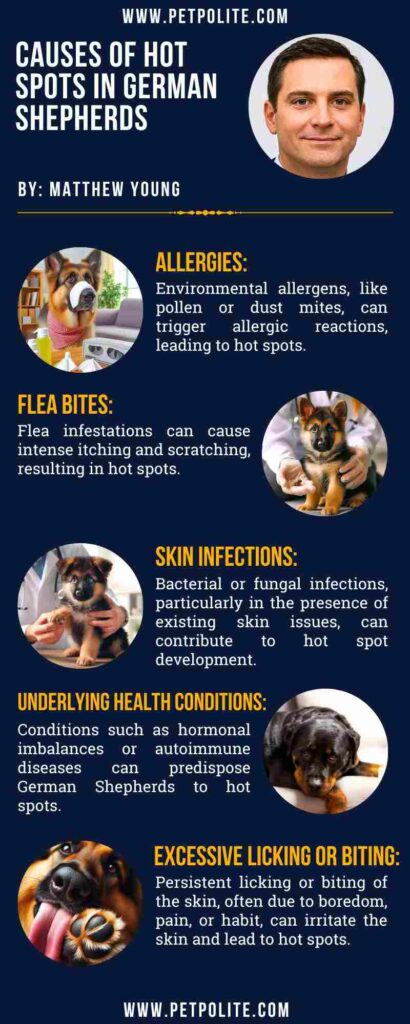
Several factors can contribute to the development of hot spots in your German Shepherd, including:
- Allergies: Environmental allergens, like pollen or dust mites, can trigger allergic reactions, leading to hot spots.
- Flea Bites: Flea infestations can cause intense itching and scratching, resulting in hot spots.
- Skin Infections: Bacterial or fungal infections, particularly in the presence of existing skin issues, can contribute to hot spot development.
- Underlying Health Conditions: Conditions such as hormonal imbalances or autoimmune skin diseases can predispose German Shepherds to hot spots.
- Excessive Licking or Biting: Persistent licking or biting of the skin, often due to boredom, pain, or habit, can irritate the skin and lead to hot spots.
Symptoms of Hot Spots:
Recognizing the signs of hot spots early can help you address them promptly.
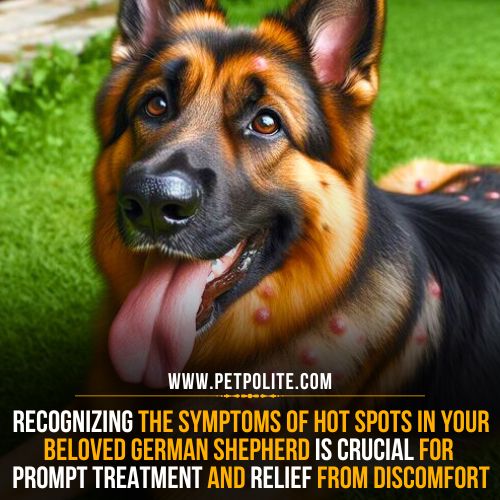
Look out for the following symptoms in your GSD:
- Red, inflamed patches of skin
- Moist or oozing lesions
- Intense scratching or licking of the affected area
- Hair loss around the hot spot
- A foul odor emanating from the skin

“Hot spots on your German Shepherd will appear moist and may ooze pus or fluid, leading to hair matting.“
Source: Purina.co.uk
Does Grooming Cause Hot Spots On Your German Shepherd?
While grooming itself isn’t a direct cause of hot spots, certain grooming practices or mistakes could potentially trigger them.
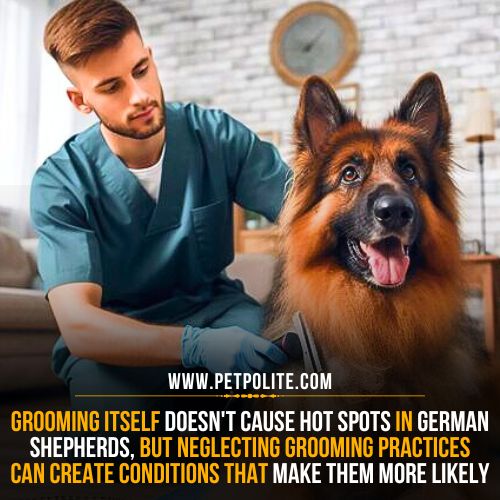

You have to keep these factors in mind before grooming your German Shepherd:
1. Grooming Techniques and Tools:
The way you groom your German Shepherd and the tools you use can play a significant role in skin health.
If you cannot handle your German Shepherd during grooming, it can cause injuries or worsening skin issues.
Similarly, excessive brushing can irritate the skin, making it more prone to hot spots.
2. Moisture Management:
Proper moisture management is crucial to prevent hot spots.
Leaving your German Shepherd’s coat damp after bathing or swimming can create an ideal environment for bacteria and fungi to thrive, potentially leading to hot spots.
3. Frequency of Grooming:
While regular grooming is important for your German Shepherd’s overall health and hygiene, over-grooming can potentially irritate the skin and cause grooming anxiety.
Strike a balance by grooming your dog as needed based on their coat type and activity level.
4. Proper Product Usage:
Using grooming products specifically formulated for dogs and avoiding harsh chemicals is essential.
Harsh shampoos or grooming products can strip the skin of its natural oils, leading to dryness and potential hot spot formation.
Grooming Techniques To Prevent Hot Spots On Your German Shepherd
To keep your German Shepherd’s skin healthy and free from hot spots requires proper grooming techniques tailored to their unique needs.
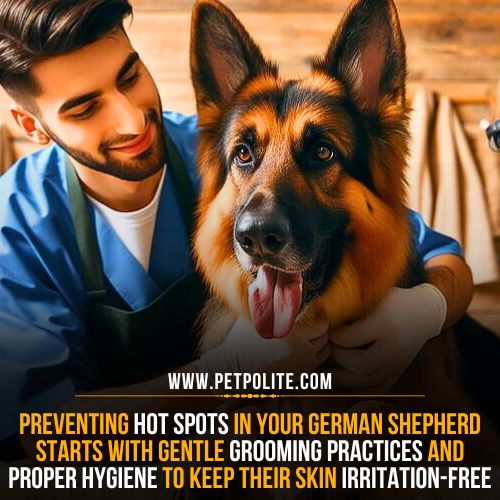

Here are effective grooming practices to prevent hot spots and maintain your furry friend’s skin health.
1. Gentle Brushing
Regular brushing is essential for your German Shepherd to remove loose fur, dirt, and debris that can contribute to hot spot formation.
Use a soft-bristled brush and gentle strokes to avoid irritating the skin.
Make sure to brush them 3-4 times a week.
Brushing not only removes debris but also stimulates the production of natural oils, which keeps the skin moisturized and reduces stress levels.
2. Proper Bathing Frequency
While bathing is necessary to keep your German Shepherd clean, excessive bathing can strip the skin of its natural oils and disrupt the skin’s pH balance.
Aim to bathe your German Shepherd every 6-8 weeks or as needed, using a gentle, moisturizing shampoo formulated for dogs.
After the bath, thoroughly rinse off all shampoo residue to prevent skin irritation.
3. Thorough Drying
After bathing or swimming, ensure your German Shepherd’s coat is thoroughly dried, especially in areas prone to moisture retention like the ears and underbelly.
Moisture trapped in the coat can create an ideal environment for bacteria and fungi to thrive, increasing the risk of hot spots.
Use a towel or a blow dryer on a low setting to ensure thorough drying, and avoid leaving the coat damp.
4. Regular Inspection
Take the time to inspect your German Shepherd’s skin regularly for any signs of irritation, redness, or hot spots.
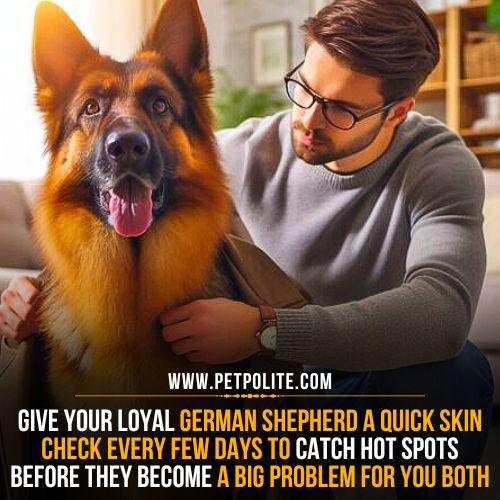

Pay particular attention to areas where the skin folds or where the fur is dense, as these areas are more susceptible to moisture buildup and irritation.
If you notice any abnormalities, consult with your veterinarian for further evaluation and treatment.
5. Trim Long Hair
Trimming long hair, especially around the ears, paws, and tail, can prevent matting and reduce the risk of hot spots.
Mats can trap moisture and debris close to the skin, creating an environment conducive to bacterial and fungal growth.
Use grooming scissors or clippers to carefully trim any long or matted hair, taking care not to nick the skin.




“To help the medicine work its magic and the hot spot heal faster, it’s important to trim the fur around it.”
Source: VCA Animal Hospitals
6. Use Hypoallergenic Products
Opt for grooming products specifically formulated for sensitive skin or hypoallergenic options to minimize the risk of skin irritation.
Harsh chemicals and fragrances in grooming products can intensify skin issues and increase the likelihood of hot spots.
Look for products with natural ingredients and no artificial fragrances or dyes to maintain your German Shepherd’s skin health and free from irritation.
How To Treat Your German Shepherd Hot Spots?
To treat your German Shepherd’s hot spots, seeking veterinary attention is a must.
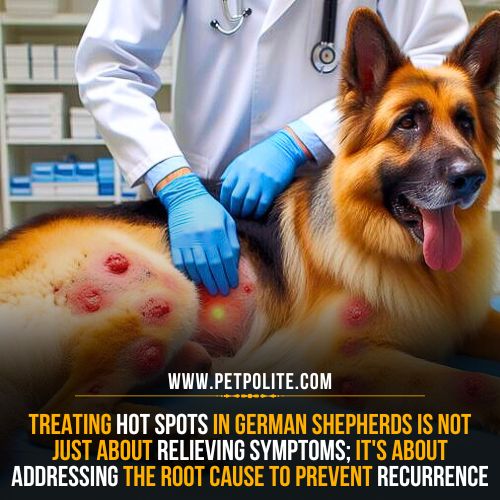

Your vet can accurately diagnose the hot spot, identify the underlying cause (allergies, parasites, infections), and rule out other skin conditions.




“Hot spots pose discomfort and itching for your dog and can persist if the root cause remains untreated.”
Source: American Kennel Club (AKC)
He will prescribe the appropriate treatment plan based on the diagnosis.
He may prescribe oral or topical antibiotics to combat any secondary bacterial infections on your dog’s skin.
Additionally, corticosteroids or other anti-inflammatory medications can be used to reduce inflammation and itching and promote faster healing.
Depending on the severity of the hot spots, various topical medications like ointments, sprays, or medicated shampoos might be recommended to soothe the skin, and prevent further infection.
If allergies are the culprit, allergy medications or immunotherapy might be recommended.
Here’s a table outlining the best treatment plan for your German Shepherd’s hot spots:
| Treatment Step | Description |
|---|---|
| Identify the Hot Spot | Look for red, moist, irritated areas on your German Shepherd’s skin. |
| Clean the Area | Gently clean the hot spot with a mild antiseptic solution. Use lukewarm water and a clean cloth to remove any dirt, debris, or crust from the area. |
| Trim Surrounding Hair | Carefully trim the hair around the hot spot to prevent further irritation and promote airflow to the area. Use blunt-edged scissors. |
| Apply Topical Treatment | Apply a vet-recommended topical treatment or spray to soothe the irritation. Look for products containing hydrocortisone or aloe vera. |
| Address Underlying Cause | Determine and address the underlying cause of the hot spot, such as allergies, fleas, or skin infections. |
| Monitor for Improvement | Keep an eye on the hot spot for signs of improvement, such as reduced redness and swelling. |
| Follow-Up with Vet | If the hot spot doesn’t improve within a few days or if it worsens, schedule a follow-up appointment with your veterinarian for further evaluation and treatment. |
How To Treat Hot Spots On Your German Shepherd At Home?
While it’s always recommended to seek veterinary attention for hot spots in your German Shepherd, here are some at-home measures you can take along with your vet’s treatment plan.
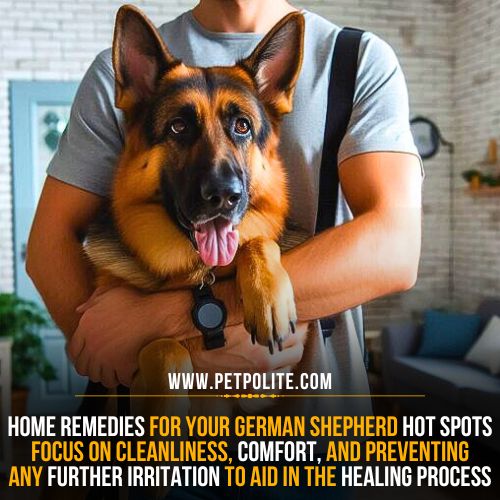

Important Note: These steps are for temporary relief and should not be considered a complete treatment plan.
1. Isolate the Area:
Use an Elizabethan collar (cone) to prevent your dog from licking or chewing at the hot spot.
This will help to promote the healing process and prevent further irritation.
2. Clean Gently:
Soak a clean washcloth in warm water and apply it as a compress to the hot spot for a few minutes.
This can help soothe the inflammation and soften any crusting.
Do not use hot water.
Once softened, gently clean the area with a vet-recommended antiseptic solution or diluted chlorhexidine shampoo (consult your vet for dilution instructions).
Avoid using harsh soaps or alcohol, which can further irritate the skin.
After cleaning, pat the area dry thoroughly with a clean, absorbent cloth. Moisture can worsen the hot spot.
3. Trim Fur:
Carefully trim the fur around the hot spot using dog clippers or scissors to help air circulate and promote faster healing.
Be cautious not to shave the area completely, as some hair helps protect the skin.
Here’s a video guide to help you treat your German Shepherd’s hot spots at home.
Conclusion:
While grooming itself doesn’t directly cause hot spots in your German Shepherd, certain practices can trigger them.
Gentle brushing, proper bathing, thorough drying, regular inspections, and addressing health issues are key to preventing hot spots in your German Shepherd.
Additionally, use hypoallergenic products and trim long hair to prevent matting.
By following these techniques, you can minimize the risk of hot spots and maintain your German Shepherd’s skin health and comfort.
Frequently Asked Questions:
Why does my German shepherd keep getting hot spots?
Your German Shepherd may be experiencing recurrent hot spots due to skin issues, moisture, inadequate grooming, behavioral factors, environmental allergens, flea infestations, or genetic predisposition.
Should I clean my German Shepherd’s hot spot?
Yes, you should clean your German Shepherd’s hot spot to remove dirt and bacteria, which can help prevent infection and promote healing. However, it’s important to consult your veterinarian for proper cleaning instructions and treatment.
Can hot spots kill a German shepherd?
Hot spots are not typically life-threatening to German Shepherds, but if left untreated, they can lead to serious complications like infection or systemic illness. It’s important to seek veterinary care promptly to prevent potential issues.
Are hot spots on German Shepherds contagious?
No, hot spots on German Shepherds are not contagious. They are typically caused by factors like allergies, moisture, or skin irritation, and cannot be transmitted to other dogs or humans.
How can I clean my German Shepherd’s hot spots?
First, trim the fur around the affected area to expose the skin. Then, gently clean the area with a mild antiseptic solution or prescribed cleanser. Finally, pat the area dry and apply any prescribed medications or ointments as directed.
How do I know if my German Shepherd gets hot spots from grooming?
If your German Shepherd exhibits signs of irritation, such as redness, swelling, or soreness, after grooming sessions, it may indicate hot spots. Excessive scratching, licking, or discomfort during grooming could also signal potential issues.
Resources Used For Research:
- A prospective study of the clinical findings, treatment and histopathology of 44 cases of pyotraumatic dermatitis – National Library of Medicine
- Hot Spots in Dogs: What are they and how are they treated? – Schwarzman Animal Medical Center
- Hot Spots in Dogs: What They Are and How to Treat Them – MedVet
- Dog Groomer’s Manual: A Definitive Guide to the Science, Practice and Art of Dog Grooming: A Book by Sue Gould
- German Shepherds: A Practical Guide for Owners and Breeders – A Book by Allison Clarke and Lizzy Brown